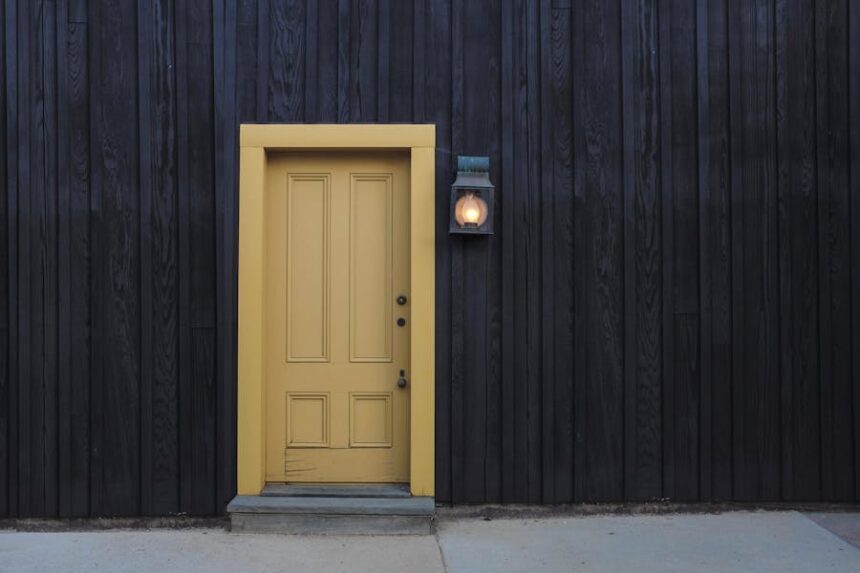Interior doors significantly impact both functionality and design. Prehung doors, which include the door already mounted on its frame, offer convenience, alignment accuracy, and faster installation. Choosing the right one for each room ensures proper fit, sound insulation, visual harmony, and enhanced durability. This guide explains how to choose prehung doors according to room type, décor, trends, and performance needs, including installation and cost insights. A large selection of Prehung Interior doors can be found in this door catalog – https://doordesignlab.com/interior-doors/prehung/prehung-interior-doors.html
- What Are Prehung Interior Doors?
- Prehung vs. Slab Interior Doors: Key Differences
- When to Choose Prehung Over Slab Doors
- Types of Prehung Interior Doors and Where to Use Them
- Solid Core, Hollow Core, and Fire-Rated Options
- Best Prehung Doors by Room
- How to Match Interior Doors with Home Decor
- Matching Doors to Modern, Traditional, or Transitional Styles
- Tips on Door Color, Finish, and Hardware
- Top Interior Door Trends for 2025
- Trending Styles, Materials, and Finishes
- Soundproofing and Privacy: Choosing the Right Doors
- Best Soundproof Prehung Doors for Bedrooms
- Doors That Improve Privacy Without Sacrificing Style
- Measuring and Installing Prehung Doors
- How to Measure Correctly for a Prehung Door
- What to Expect During Installation
- Costs and Budgeting for Prehung Interior Doors
- Price Range by Door Type and Room
- Labor and DIY Installation Costs
- FAQ
What Are Prehung Interior Doors?
Prehung interior doors come as a ready-to-install unit: the door slab is already hinged to a door frame (also called a jamb), often pre-drilled for hardware, and sometimes including casing. This assembly simplifies the installation process, especially for new construction or major remodels where door frames are being replaced.
The key advantage is precision. Prehung doors are manufactured with factory accuracy, ensuring better alignment and sealing than doors hung manually on-site. This is especially important for soundproofing and smooth operation, reducing gaps that often occur with improperly fitted slabs. They also save time for installers, as they eliminate the need for aligning hinges and fitting a new frame separately.
Prehung doors are ideal for new openings or where the frame is damaged or out-of-square. However, they require more space and careful handling during transport and installation due to their size and weight.
Prehung vs. Slab Interior Doors: Key Differences
Slab doors are sold without hinges, frame, or hardware, making them more flexible for custom renovations or replacing just the door leaf. They require more skill to hang correctly, particularly if the frame is old, warped, or misaligned.
Prehung doors, in contrast, ensure consistency and speed. They’re more beginner-friendly and minimize errors, but they are bulkier, cost slightly more, and require complete removal of the old frame. For remodels involving wall replacement or damaged jambs, prehung doors are the preferred option.
When to Choose Prehung Over Slab Doors
Choose prehung doors if:
- You’re working with new walls or new construction.
- The existing door frame is damaged or non-standard.
- You want fast, error-free installation.
- You’re upgrading to improve soundproofing or security.
Choose slab doors if:
- The existing frame is in excellent condition.
- You need to match custom trims or existing aesthetics.
- You’re replacing only the door panel.
Types of Prehung Interior Doors and Where to Use Them
Different rooms have different functional needs. Understanding the types of prehung doors available helps match the door’s purpose to its placement in the home.
Solid core doors are heavy and offer superior soundproofing and durability. They are ideal for bedrooms, bathrooms, and offices where privacy and noise control are essential. Hollow core doors are more budget-friendly and lightweight, best suited for closets, pantries, or low-traffic areas.
Fire-rated doors are a requirement in some cases (like doors between garages and living spaces), but also an excellent safety feature for utility rooms or basements. Some prehung doors also come with glass panels, suited for living rooms or spaces where natural light is desirable, though they should be avoided in bathrooms or bedrooms.
Moisture-resistant options are essential for bathrooms and laundry rooms. In these spaces, choose doors with PVC or water-sealed composite cores that resist warping. Always consider the door’s swing direction — especially in tight spaces like powder rooms — and select between left- or right-hand inswing or outswing as needed.
Solid Core, Hollow Core, and Fire-Rated Options
Solid core doors are filled with engineered wood or MDF, giving them a high-end feel and superior noise reduction. They mimic the weight and feel of solid wood doors at a lower cost. Use them for bedrooms, offices, and shared spaces.
Hollow core doors are lightweight and affordable but provide poor sound insulation. They consist of a honeycomb cardboard or foam core and are most appropriate for storage rooms or rooms where noise isn’t a concern.
Fire-rated doors are built with specialized cores and materials that withstand fire for a set duration (typically 20 to 60 minutes). They are heavier, more secure, and required by code in some transition areas like garage entries.
Best Prehung Doors by Room
Bedrooms: Choose solid core prehung doors with a smooth or panel design. Prioritize noise isolation and durability.
Bathrooms: Go for moisture-resistant, solid or semi-solid core doors. Frosted glass may be acceptable for private master suites but is rarely used for public bathrooms.
Living Rooms: Style plays a bigger role here. Consider panel, French, or barn-style doors with glass inserts, especially if they lead to dining rooms or offices.
Kitchens and Pantries: Lightweight hollow core or MDF doors work well unless it’s an open-concept design requiring visual continuity.
Home Offices: Use sound-rated or acoustic-rated prehung doors with solid cores to minimize disturbances.
How to Match Interior Doors with Home Decor
Interior doors should harmonize with your home’s overall style, not clash with it. The material, finish, and door design contribute to a cohesive aesthetic.
In modern homes, minimalistic flush doors or smooth-panel styles work best. Choose painted finishes in matte black, white, or soft gray to match contemporary trims. Sleek hardware in brushed nickel or matte black enhances the look.
Traditional homes benefit from raised panel designs, often stained wood or painted in neutral tones. Use bronze or brass hardware for a classic finish. Colonial, Craftsman, and Victorian styles often use multi-panel designs or even decorative molding.
For transitional interiors, opt for shaker doors. They balance simplicity and detail, suiting a wide range of color palettes and trim styles. Always match the door color to either the trim or the wall tone. Consistency in sheen (matte, satin, gloss) also improves visual unity.
Matching Doors to Modern, Traditional, or Transitional Styles
- Modern: Flush, slab, or shaker doors in solid colors, often without visible grain. Hardware is clean, often angular.
- Traditional: Multi-panel wood or MDF doors with raised details. Stained finishes and ornate knobs or levers.
- Transitional: Flat panel or shaker styles in neutral colors with subtle trim details. Mix metal finishes with wood tones.
Tips on Door Color, Finish, and Hardware
- Choose a color that complements flooring and wall tones.
- Satin or semi-gloss paint resists fingerprints and is easier to clean.
- For consistency, match all door hardware across the house, or deliberately contrast in key areas (e.g., black handles in white rooms).
- Match hinges to door handles for a clean look.
Top Interior Door Trends for 2025
Designers are embracing bold materials and minimalism in 2025. Full-height doors (from floor to ceiling) are trending in luxury homes, creating a seamless wall effect. These work well in modern and open-plan interiors.
Textured finishes, such as reeded or slatted wood patterns, are gaining traction. They add subtle depth without overwhelming minimal décor. Natural wood tones are returning, with walnut and white oak being top choices.
Smart doors are making inroads into the interior space — particularly for home offices — with integrated locks or sensors. Sustainability also drives innovation: manufacturers are offering more eco-friendly prehung doors with recycled cores and low-VOC finishes.
Trending Styles, Materials, and Finishes
- Slatted Wood Panels: Offer visual texture in Scandinavian or modern homes.
- Matte Finishes: Preferred for their modern aesthetic and minimal glare.
- Natural Veneers: Bring warmth to minimalist or transitional interiors.
Smart and Eco-Friendly Door Innovations
Smart locks, soft-close hinges, and door sensors are increasingly available for interior doors. These enhance convenience and security, especially in shared households.
Sustainable options include doors made from FSC-certified woods, recycled wood fiber, or low-emission MDF. Manufacturers are responding to consumer demand for healthier, greener homes.
Soundproofing and Privacy: Choosing the Right Doors
Noise reduction is a critical factor, especially in multi-occupant homes. Bedrooms, offices, and nurseries benefit significantly from solid or acoustic-rated prehung doors. These reduce airborne sound by sealing gaps and providing mass to absorb vibration.
Look for doors with a Sound Transmission Class (STC) rating above 30 for residential use. Solid wood and solid core doors typically perform best. Use weather stripping around the frame for added insulation.
For shared bathrooms or guest rooms, privacy is as important as soundproofing. Choose doors with minimal glass and ensure the latch hardware is secure and quiet. Aesthetics should not come at the cost of functionality in these rooms.
Best Soundproof Prehung Doors for Bedrooms
Solid MDF or composite core doors with tight-fitting jambs are ideal. For best performance, pair with acoustic seals or automatic door bottoms.
Doors That Improve Privacy Without Sacrificing Style
Frosted or tinted glass can offer semi-privacy in home offices or ensuite bathrooms. Use minimal hardware and magnetic latches to reduce noise during use.
Measuring and Installing Prehung Doors
Accurate measurement is crucial. Begin by removing the trim and measuring the rough opening: width (stud to stud), height (subfloor to header), and depth (drywall to drywall). Standard widths are 24″, 28″, 30″, 32″, and 36″. Round up to the nearest standard if in doubt.
Before installation, verify that the floor is level and walls are plumb. Use shims to level the frame in the opening. Secure the frame with finishing nails or screws through the jamb into the studs.
For DIYers, prehung doors offer a forgiving installation process. However, if you’re installing multiple doors or working with uneven framing, hiring a professional ensures perfect results.
How to Measure Correctly for a Prehung Door
- Width: Measure top, middle, and bottom; use the smallest.
- Height: Measure both sides; use the smallest.
- Depth: Match the thickness of the wall — usually 4 9/16″ or 6 9/16″.
What to Expect During Installation
Expect 1–2 hours per door, longer if demolition or trim work is needed. Protect flooring and prepare for some drywall touch-up. Caulking and repainting are typically required to finish the trim edges cleanly.
Costs and Budgeting for Prehung Interior Doors
Prehung interior doors vary widely in price. Hollow core doors start at $70–$120, while solid core models range from $150–$350. Custom or fire-rated doors can cost $400 and up. Glass panel or French doors are also on the higher end.
Installation costs range from $100–$250 per door, depending on complexity. DIY installation saves on labor but requires precision. Don’t forget to budget for hardware, trim, paint, and disposal of old doors.
For whole-home upgrades, buying in bulk can reduce cost per door. Always request quotes from multiple installers and check if the cost includes frame adjustments or finish carpentry.
Price Range by Door Type and Room
- Hollow Core (Closets, Low-Use Rooms): $70–$130
- Solid Core (Bedrooms, Offices): $150–$300
- Fire-Rated or Glass Insert: $300–$600
Labor and DIY Installation Costs
- Professional Install (Per Door): $120–$250
- DIY Costs: $0 labor, but factor in tools and time
- Extra Costs: Disposal, trim replacement, painting
FAQ
What is the difference between a slab and a prehung interior door?
A slab is just the door panel; a prehung includes the frame and hinges for easier, precise installation.
Are solid-core interior doors worth the cost?
Yes. They offer better durability and soundproofing, ideal for private and high-traffic areas.
How do I know what size prehung door I need?
Measure the rough opening’s width, height, and depth, and round up to the nearest standard door size.
Can I install a prehung door by myself?
Yes, with basic tools and precision; however, misalignment issues can occur without experience.
What’s the best prehung door for bathroom privacy?
A solid or moisture-resistant core door with a privacy latch provides sound isolation and durability.




